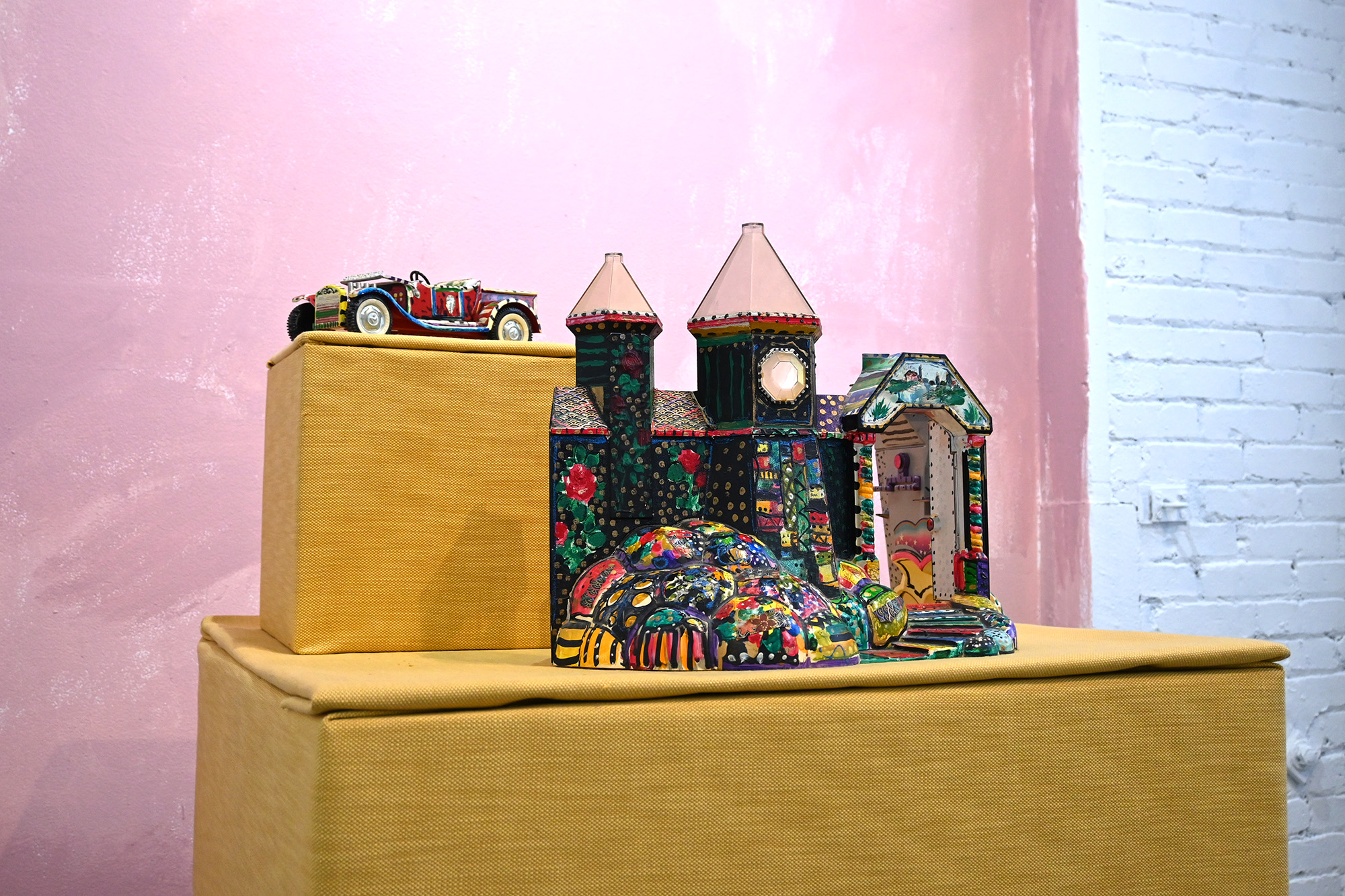

By all accounts, Ursula Sternberg was a remarkable woman. Full of creative verve and a passion for artistic experimentation, her painting and drawing oeuvre expands from traditional landscape and figural explorations into costume and textile design, and outsider art-styled sculptural embellishment.
A recently installed exhibition at InLiquid Gallery, Ursula Sternberg: Daydream offers a curated display of her paintings and objects spanning almost fifty years of creation. Upon entering the gallery space, the viewer is immediately greeted with a joyous and colorful foray into her eclectic practice. Many of her drawings are simply tacked to the white walls with magnetic pushpins, in brightly clustered groupings.

Sternberg's post war years were prolific. Her paintings presenting feminine forms vacillate between academic studies and more candid gestures of bodies in repose. Carefully constructed calligraphic lines suggest slow looking. I find myself drawn to a standing figure, clad just in small panties, with her back to us. She is surrounded by a dreamy patterned wash of flowers. But there is something vital in her stance that challenges the trope of a beautiful woman in nature; the position of her legs and hand on hip suggest she is in control of her space, as well as the roses sprouted around her. While her gaze is averted, this is no passive odalisque. A similarly dated ink study from the mid 1970’s features a male nude seated in a plush armchair, grounding him physically and conceptually in a homey interior. His legs extend out towards a rug on a planked floor, while his arm languidly drapes over the top of the furniture. He fills, rather than commands the pictorial space. His head and body are turned in profile towards the center of the room. If we follow his visual path we are alerted to a female face included in another smaller frame off to the right of the composition. But as his gaze passes hers, we instinctively feel this scene includes the artist observing her model. This portrait within the other bears a scrawled repeat of the wall patterning, suggesting a mirrored reflection rather than a formal picture. The placement of the female reflection in the extreme corner of the frame marks her presence as a quickly captured glimpse rather than an intended subject of study. This is but one example among others of how Sternberg plays with expectations of the viewer, and perhaps of herself.

Some of the artist’s more academic figure drawings included in the exhibit share an ambiguity of identity, and play with the idea of privacy and belonging. Informal huddles of musicians positioned with their backs to the viewer guard the magic taking place within their close circle. In another drawing within this musical grouping, a repeated gesture of a conductor reaches out into empty space on the page. We can feel him activate the air with his intense plea. It is the same with Sternberg. She conducts a world of beauty and fantasy, ever shaping it to her desire. We are witness to this sway, and are pulled into her multi-faceted vision.
Threads of gender and identity are also woven through her costume designs, but these images are arguably more didactic. Frontally facing characters in plumed hats and Medieval armor contain Sternberg’s scribbled notations in the margins. These intimate sketches fluidly map her process and ruminations. On one multi-portrait page we make out the words “The moustache is blacker on one side” and under that line, “I wish I could grow hair on my face.”

Decorated utilitarian objects on display with the works on paper subtly reinforce figurative connections to the domestic realm alongside idyllic scenery. Painted furniture, looking ‘found’ rather than sculpturally rooted in regional craft, reveals a fervent urge to embellish the everyday; to mark the profane with the sacred. A zebra-striped chair on a pink pedestal takes on a decidedly figural stature in the gallery. The object is easily imagined as part of Sternberg's bohemian atelier; the blocky stenciled notation of “CHAIR” on the back teases the formality of the exhibit. This interplay of text and surface is celebrated again in a humidor box with “75 HAPPY’ spelled out brightly in stenciled letters on the side. It has a compartmentalized landscape on top. The ‘happy’ text designation would reveal a naiveté in another context, but here it offers a slightly incongruous graphic, juxtaposed with a picturesque valley. A small house and palm tree emerge from rolling green and yellow hills in fairy tale reverie.

There is a raw, unaffected love of art making in this show that is at times unabashedly personal. The artist is in some ways just as exposed and laid bare as her models before us in this exhibit, and yet she challenges us to see her completely. We encounter Ursula Sternberg as a shapeshifter. One moment we experience her as an art ingénue with an outsider's decorative aesthetic that at times approaches horror vacui- and then a sinuous calligraphic line along the back of a nude reaches a formal sophistication that teeters on the sublime. A watercolor study of a pink flower on heavily deckled handmade paper includes the phrase “This is not a rose” along the bottom, channeling Magritte’s "Ceci n'est pas une pipe" (“La Trahison des Images”). It’s as though Sternberg is subverting Modernist gambits with her floral patterns that float freely between naturalistic and cartoon renderings. Expectations of historical academic training alongside folk traditions are unmistakably intermingled and linked in this exhibit, and confront the viewer with ideas of inclusion and bodily autonomy. As viewers, we become part of her small group ensembles in each vignette section in the gallery, and as such we are invited to corroborate Ursula Sternberg's dreams. Ultimately, the physical arrangement of her work in the space stand as artifacts of a full artistic life, well lived.
The exhibition Ursula Sternberg: Daydream is on display from December 10, 2022 - January 21, 2023.





